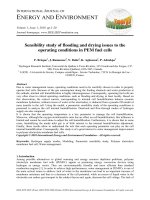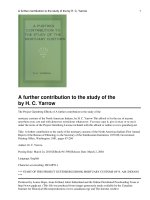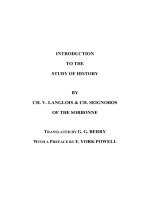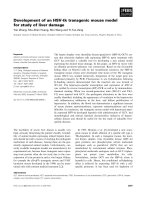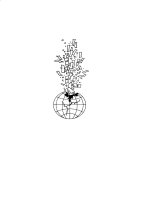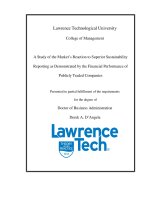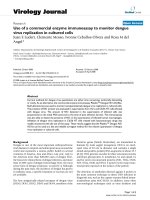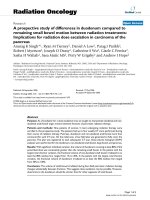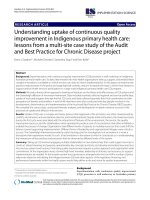Study of liver surface imaging marker to monitor chronic liver disease progression
Bạn đang xem bản rút gọn của tài liệu. Xem và tải ngay bản đầy đủ của tài liệu tại đây (6.61 MB, 149 trang )
STUDY OF LIVER SURFACE IMAGING MARKER
TO MONITOR CHRONIC LIVER DISEASE
PROGRESSION
YAN JIE
(B.Eng. SHANGHAI JIAO TONG UNIVERSITY)
A THESIS SUBMITTED
FOR THE DEGREE OF DOCTOR OF PHILOSOPHY
DEPARTMENT OF PHYSIOLOGY
NATIONAL UNIVERSITY OF SINGAPORE
2015
DECLARATION
I hereby declare that this thesis is my original work and it has been written by
me in its entirety.
I have duly acknowledged all the sources of information which have been used
in the thesis.
This thesis has also not been submitted for any degree in any university
previously.
Yan Jie
25 Apr 2015
Acknowledgements
First of all, I would like to give my utmost gratitude to my supervisor Prof.
Hanry Yu, who ignored my ignorance and offered me the chance of coming to
Singapore. He is a smart, knowledgeable and patient mentor, who has tried his
best to not only shape my scientific thinking, but also teach me the philosophy
of life. I am deeply motivated by his passion in science and inspired by his
boundless ideas. I am also grateful for all the opportunities he has provided for
me in the past four years. The four year study in Singapore has been the most
rewarding and memorable period in my life that will shape my whole life. It
has been a great pleasure to study in his lab because of the great group and
working environment that Prof. Yu has put together.
I will also extend my gratitude to my co-supervisor Prof. Peter So. He has
given me a lot of guidance especially during my half-year residence at MIT.
His scientific expertise stimulated me so much that my project would have
been impossible to move forward smoothly without his valuable advice. I
enjoyed every discussion with him and will never forget his humor and
laughter. Besides, I will thank Singapore-MIT Alliance Research and
Technology (SMART) who has provided me with my scholarship and the
precious opportunity to do research in both Singapore and MIT. SMART to me
is a big family where all members work together to create an atmosphere
conducive to scientific discussion. I have learned a lot and enjoyed every
gathering with them.
Also importantly, I am grateful to my beloved parents who have constantly
given me spiritual support and my husband who has given me a lot of
encouragement, especially in my later part of PhD life. Whenever I felt lost,
bored and depressed, his unconditional support gave me the courage to brave
out whatever hardship I faced in my studies.
Many thanks to all my colleagues: Mr. Yuzhan Kang and Dr Junjun Fan, who
have patiently helped me gained the essential techniques for animal
experiments; Dr. Shuangmu Zhuo and Ms Qiwen Peng, who have patiently
taught me techniques of optical path adjustment; Dr. Huipeng Li, Dr. Junjie
Wang and Dr. Shuoyu Xu, who have kindly instructed me on the skills of
imaging processing and statistics analysis. My sincere gratitude is also given
to Dr. Lei Xia, Dr. Toh Yi-Chin who has kindly provided scientific input to
help me define my PhD qualification exams. Besides, I have been always
enjoying my office time with Ms Jiangwa Xing, Ms Wenhao Tong and Ms
Qiwen Peng. They are three wonderful optimistic happy Sagittarius girls who
can always find a way to dispel vexation. It was so much fun to stay in lab
because of them.
Last but not least, my thanks goes to my examine committee members, who
will most directly determine if I could finally complete my life as a student. I
am grateful not just for their precious time, but also the guidance and
suggestions they will provide during my defense.
Table of Contents
Summary…… i
List of Publications iii
List of Tables iv
List of Figures v
List of Abbreviations xi
Chapter 1 Introduction 1
1.1 Motivation 1
1.2 Objective and specific aims 3
1.2.1 Specific Aim 1: To characterize hepatic microcirculation, and correlate the
feature changes of hepatic microcirculation with the liver fibrosis progression 3
1.2.2 Specific Aim 2: To explore liver surface structural features that relate to liver
fibrosis… 4
1.2.3 Specific Aim 3: To delineate structural and biochemical features that relate to
hepatic steatosis 5
1.3 Outline of the whole thesis 6
Chapter 2 Background and Significance 7
2.1 Pathogenesis and diagnosis of chronic liver disease 7
2.1.1 Liver—anatomy and physiology 7
2.1.2 Hepatic fibrosis and cirrhosis 9
2.1.3 NAFLD and NAFLD derived hepatocellular carcinoma 14
2.1.4 Clinical methodology of diagnosis 16
2.2 Imaging features of liver surface 19
2.2.1 Extracellular matrix 20
2.2.2 Autofluorescence of endogenous fluorophores 20
2.2.3 Hepatic surface microcirculation 21
2.3 Imaging modality for liver surface imaging 24
2.3.1 Laser speckle contrast imaging 24
2.3.2 Two photon excitation and second harmonic generation microscopy 27
2.3.3 Raman spectroscopy 33
Chapter 3 Study of Hepatic Microcirculation in Liver Fibrosis 37
3.1 Introduction 37
3.2 Materials and methods 40
3.2.1 Design of Intra-vital imaging window for in vivo imaging of liver 40
3.2.2 Statistics of laser speckle 45
3.2.3 Experiment setup and image acquisition 46
3.2.4 Liver fibrosis model establishment by Bile Duct Ligation (BDL) 47
3.2.5 Animal preparation for in vivo microcirculation study 49
3.2.6 Image segmentation and features extraction 50
3.2.7 Quantification and statistics analysis 51
3.2.8 Liver sample extraction, processing and staining 52
3.2.9 Histopathological scoring of tissue sample 53
3.3 Results and discussions 54
3.3.1 Intravital imaging window for live liver imaging 54
3.3.2 Spatial and temporal laser speckle contrast 56
3.3.3 The Histopathological findings from the tissue section of BDL model 60
3.3.4 Live image acquisition with the laser speckle and wide-field microscope 63
3.3.5 Quantification of the four parameters 66
3.3.6 Vessel cross-section speed comparison 67
3.3.7 The onset of the microcirculation lesion is the early to middle fibrosis 68
3.4 Summary and conclusions 70
Chapter 4 Study of Liver Surface Structural Features Related to Liver Disease
status ……… 71
4.1 Introduction 71
4.2 Materials and methods 74
4.2.1 Animal preparation for in vivo imaging 74
4.2.2 Nonlinear microscope and image acquisition 74
4.2.3 Feature extraction and quantification 75
4.3 Results and discussions 77
4.3.1 Liver surface in vivo imaging using two photon microscope 77
4.3.2 Structural features of liver surface 82
4.3.3 Redox ratio indicates hepatocytes function 86
4.4 Summary and conclusions 87
Chapter 5 Study of Progression Mechanism of Non-Alcoholic Fatty Liver Disease 88
5.1 Introduction 88
5.2 Materials and methods 90
5.2.1 Animal model for NAFLD and sample preparation 90
5.2.2 Raman spectroscope and data acquisition 91
5.2.3 Data analysis 93
5.2.4 Tissue autofluorescence background subtraction 93
5.2.5 Biological components analysis (BCA) 94
5.2.6 Principle component analysis (PCA) 95
5.3 Results and discussions 97
5.3.1 Mean Raman spectra of tissue at different time points 97
5.3.2 Selection of basic chemical components 100
5.3.3 Biological component analysis result 103
5.3.4 Principle component analysis result 105
5.4 Conclusion 108
Chapter 6 Conclusion and recommendations for future research 109
6.1 Summary 109
6.2 Recommendations for future research 110
References …. 112
i
Summary
Chronic liver disease, especially non-alcoholic fatty liver disease (NAFLD), is
affecting increasing number of people worldwide. However, until today the
progression mechanism of chronic liver disease is not yet fully understood.
Looking for imaging markers from liver surface is an important step for
understanding disease progression mechanism and possibly systematically
monitoring chronic liver disease progression in the future. This thesis presents
a study of imaging markers from liver surface using different optical
microscopic techniques. The hypothesis driving the whole study is that hepatic
microcirculation is a meaningful marker for chronic liver disease, and triggers
the progression of the disease. Since chronic liver disease is usually composed
of complex histological spectra, we isolated two important histological spectra
of chronic liver disease, i.e. fibrosis and steatosis, and searched imaging
markers from these aspects.
To begin the study, we designed and developed an intra-vital imaging window
for live imaging of rodent liver. On this animal investigation platform, we
established a quantitative method to characterize the hepatic microvasculature
related features during the fibrosis progression and correlated the change of
features with the staging of the fibrosis. We discovered that the drastic change
of the hepatic microcirculation took place in the early to middle stage of the
fibrosis. From the result, we inferred that the microcirculation lesion drove the
progression of fibrosis by advancing the changes of the other features such as
collagen accumulation.
In the second part of the work presented in this thesis, we kept on looking for
structural features of liver surface that related to hepatic fibrosis. Nonlinear
ii
two photon microscope was used to take images from liver surface of both
normal rat and fibrotic rat. Five features about the collagen/elastin
morphology and redox status of hepatocytes were extracted and quantified.
They were found to be related with the fibrotic status.
The third part of this work is devoted to studying the imaging marker of
steatosis. We delineated the structural feature changes using the Raman
micro-spectroscopy, and recognized the dominant role that fatty acid is
playing in disease progression. We envision the integration of all the imaging
markers we studied in this thesis and the comparison of the significant onset of
structural feature change and the microcirculation feature change to further
prove the hypothesis.
Current thesis work is based mainly on the publication 1 and 2 in the list of
publications on page iii.
iii
List of Publications
1. Jie Yan, Yuzhan Kang, Shuoyu Xu, Lee-Ling S.Ong, Shuangmu Zhuo, Ralph M
Bunte, Nanguang Chen, H. Harry Asada, Peter T.C. So, Ian R. Wanless, Hanry Yu.
In vivo, label-free quantification of liver microcirculation using dual modality
microscopy. Journal of Biomedical Optics 2014; 19(11):116006.
2. Shuangmu Zhuo*, Jie Yan*
, Yuzhan Kang, Shuoyu Xu, Qiwen Peng, Peter T.C. So,
Hanry Yu. In vivo, label-free, three-dimensional quantitative imaging of liver
surface using multiphoton microscopy. Applied Physics Letter 2014; 105(2): 023701.
(*Shuangmy Zhuo and Jie Yan contribute equally)
3. Wen Hao Tong, Jie Yan
, Xin Hong, Nisha Hari Singh, Shu Rui Wang, Bramasta
Nugraha, Lei Xia, Ciprian Iliescu, Hanry Yu. Perfusion sandwich-constrained
hepatocyte spheroid culture. Submitted to Biomaterials.
4. Wai Jin Tan, Jie Yan
, Shuoyu Xu, Aye Aye Thike, Boon Huat Bay, Hanry Yu,
Min-Han Tan, Puay Hoon Tan. Second harmonic generation microscopy is a novel
technique for differential diagnosis of breast fibroepithelial lesions. Submitted to
Breast Cancer Research.
5. Stefan Stanciu, Shuoyu Xu, Qiwen Peng, Jie Yan
, George A. Stanciu, Roy E.
Welsch, Peter T. C. So, Gabor Csucs & Hanry Yu. Experimenting Liver Fibrosis
Diagnostic by Two Photon Excitation Microscopy and Bag-of-Features Image
Classification. Scientific Report 2014; 4: 4636.
6. Shuoyu Xu, Chiang Huen Kang, Xiaoli Gou, Qiwen Peng, Jie Yan
, Shuangmu Zhuo,
Chee Leong Cheng, Yuting He, Yuzhan Kang, Wuzheng Xia, Peter So, Roy Welsch,
Jagath Rajapakse, Hanry Yu. Quantification of liver fibrosis via surface imaging of
the Glisson’s capsule. Submitted to PLoS ONE.
7. Shuoyu Xu, Yan Wang, Dean C.S. Tai, Shi Wang, Chee Leong Cheng, Qiwen Peng,
Jie Yan
, Yongpeng Chen, Jian Sun, Xieer Liang, Youfu Zhu, Jagath C. Rajapakse,
Roy E. Welsch, Peter T.C. So, Aileen Weeemail, Jinlin Houemail, Hanry Yu.
qFibrosis: Quantitative Biopsy-based Liver Fibrosis Assessment in Animal Model
and Chronic Hepatitis B Patients. Journal of Hepatology 2014; 61(2): 260-269.
iv
List of Tables
Table 2-1. Scoring systems of liver fibrosis. The Ishak system has 6 grades; the Metavir
system has 4 grades. 17
Table 2-2. The advantages and disadvantages of both invasive and non-invasive
approaches for liver disease diagnosis. 18
Table 2-3. The optimal excitation wavelength and emission peak center wavelength of
endogenous fluorophores of liver 21
Table 2-4. The optical properties of the two photon excitation microscope 30
Table 3-1. The specifications of long pass filter set. 46
Table 4-1. Quantitative characterization of parameters derived from two photon imaging
85
Table 5-1. The number of samples in each time point 91
Table 5-2. Orders to be used in constrained/unconstrained polynomial fit 94
Table 5-3. The number of spectra averaged in each time points 97
Table 5-4. The selected basic biochemical components and the reason of selection 100
Table 5-5. The fitting coefficients of the basic components 103
v
List of Figures
Figure 2-1. The anatomy of rat liver, the drawing shows multiple liver lobes and the
drainage system of the liver. The drainage system includes portal vein (blue), hepatic
artery (red) and biliary duct (yellow). ML: Middle lobe; LLL: Left lateral lobe; RLL:
Right lateral lobe; CL: Caudate lobe; CP: Caudate process. Source: Image adapted from
published literature (20). 8
Figure 2-2. The microanatomy structure of liver. The liver is composed of hexagonal
microstructures called liver lobule. Liver cells is grouped into sheets and groups
surrounded by sinusoids. Source: image adapted from published literature (22) 9
Figure 2-3. Mechanisms of liver fibrosis. The primary hepatotoxic agents induce
inflammatory response among hepatic cells through the production of mediators.
Damaged hepatic cells (hepatocytes and biliary cells) release ROS and inflammatory
cytokines to activate the Kupffer cells and T cells. The inflammatory cells activated the
HSCs and other type of myofibroblasts. Activated HSCs secrete cytokines so that to
retain the activated status, and to control the activity of the inflammatory cells. In the
mean time they secret large amount of fibril collagen (ECM) at the damaged location to
replace the apoptotic hepatic cells. If the injury persist, this circle goes on and on till
cirrhosis and liver failure. But once the injury ceased, the degradation of ECM surpasses
the synthesis of ECM, this explains the reversibility of fibrosis. The degradation of
collagen is induced by the increased activity of matrix metalloproteinases (MMPs) and
decreased expression of tissue inhibitor of metalloproteinases (TIMPs). The reversal of
fibrosis also involves the apoptosis of activated HSCs and regeneration of hepatocytes.
CCL21, C-C chemokine ligand 21; MCP-1, monocyte chemoattractant protein–1; MIP-2,
macrophage inflammatory protein–2; NS3, HCV nonstructural protein 3; NS5, HCV
nonstructural protein 5; PAF, platelet-activating factor. Source: image adapted from
published literature (6) 12
Figure 2-4. Overview of the pathway that involves in NAFLD related
hepatocarcinogenesis. Inside the pink box, there are onco-MicroRNAs (oncoMiRs) that
ablate expression of tumor suppressor. Inside the green box, there are tumor suppressor
miRs. Black arrow indicates the activation of downstream signaling. Red blunted lines
indicates inhibition, bidirectional arrows indicate crosstalk between signaling molecules.
The red ‘×’ indicates the abrogation of signaling of specific molecules. Figure is adapted
from reference (63) 16
Figure 2-5. The primary vascular system of liver lobule is composed of portal vein-PV,
the central vein-CV and the artery-A. After repeated branching, the portal vein and artery
(zone I) is divided to small sinusoids (Zone II), nutrition/oxygen supply and metabolic
vi
exchange occur in sinusoids. Sinusoids combine together and converge to central vein
(zone III). 23
Figure 2-6. (a) Raw speckle image from rat’s thinned skull, the grainy pattern is showed.
(b). the corresponding spatial contrast image computed using a 5×5 window. Figure
adapted from reference (86). 25
Figure 2-7.
The scheme for one- and two-photon excitation. We take 1 350 for
example. Fluorescent molecule is excited and shift to excited state and later relaxes back
with emission at 420nm. In the identical two-photon excitation event, two photons at
700nm are absorbed simultaneously. The picture is adapted from
. 28
Figure 2-8. The Jablonski diagram illustrating the difference of SHG and TPEF. SHG:
two photons are converted to a single photon with twice the energy (half of the
wavelength). TPEF: two photons are absorbed simultaneously to excite a molecular
energy state that can emit fluorescence. 31
Figure 2-9. Two-photon microscopy images of liver in vivo after ischemia-reperfusion
injury at various reperfusion time points. Figure adapted from reference (112). 33
Figure 2-10. Vibrational energy level diagram showing Rayleigh and Raman scattering. 35
Figure 3-1. The first generation of rat liver imaging window. (a) The design and size of
the inner ring, which is to be installed onto the skin of animal through surgical suturing.
(b) The assembly diagram, every part can be locked or screwed to ensure stability. 41
Figure 3-2. The final prototype of the rat imaging window. (a) The u-shape holder to lock
the inner window and the ring holder to connect the u-shape holder to the stage. (b) The
plate that holds the animal. It will be inserted to the microscope sample stage. (c) The
imaging window with all parts assembled. 42
Figure 3-3. The second generation rat imaging window design. The design has been
simplified to three components. It is handy to use and largely reduces the cost of
fabrication. 43
Figure 3-4. Different views of mice imaging window design. This design is revised based
on the second generation rat imaging window design, but it is in a much smaller size. It
could be stabilized to the microscope’s sample plate like histology slides. This feature
makes it able to adapt to different microscope models. 44
vii
Figure 3-5. The fabrication of mouse imaging window. (a) There are three main
components in this design; only the inner ring is made of medical grade titanium, the
other two parts are made of aluminum alloy. (b) The assembled window is showed. The
mouse window is designed at the size of a glass slide, so it easily fits to different
microscope models. 44
Figure 3-6. (a) Schematic illustration of the optical set-up. For the wide-field fluorescence
microscope, the light generated by mercury lamp passes through a long pass filter set
(ET470/24x, 510dcxr, HQ525lp, Chroma Technology). The LSCI recruits a diode laser
(λ=638nm, 25mW output) as light source with an incident angle of about 30deg.
Resulting images were collected by a CCD camera. (b) Wide-field fluorescence image. (c)
Blood flow contrast color map of the same imaging site. Scale bar: 100um. 47
Figure 3-7. The illustration of the transaction site of on the common bile duct. Picture is
adapted from ref (150). The bile duct is transected between two ligatures. RLL: right
lateral lobe. ML: middle lobe. LLL: left lateral lobe. CL: caudate lobe. CP: caudate
process. 49
Figure 3-8. The flowchart of imaging processing procedure. Raw wide-field fluorescence
image is firstly Frangi filtered and thresholded to obtain the binary image. Delaunay
triangle was computed and the MAT was acquired to get the vessel centerline and radius.
Using the resulting centerlines and radii of all vessels, the vessel structure could be
reconstructed, so that the feature of number of junction, average vessel breadth and vessel
area can be extracted. Combing the reconstructed structure and the laser speckle contrast
flow map enables us to identify the vessel region and obtain the averaged flow speed. 51
Figure 3-9. The illustration of using the imaging window on rat. (a) Suturing the inner
ring to the abdominal skin of the rat. (b) Connecting both the U-shape holder and the ring
holder to the inner ring. (c) Locking the ring holder to the plate. (d) Placing the plate to
the microscope stage. 55
Figure 3-10. (a) The wide field fluorescence image of liver surface. (b) The corresponding
laser speckle raw images. (c) The resulting flow map using spatial contrast with window
size equals to 3×3. (d) The resulting flow map using spatial contrast with window size
equals to 5×5. (e) The resulting flow map using spatial contrast with window size equals
to 7×7. (d) The resulting flow map using spatial contrast with window size equals to 9×9.
57
Figure 3-11. (a) To understand why window size 5×5 and 7×7 are widely used to calculate
the spatial contrast, three points are chosen from the image, a 11×11 observation window
on each point, the mask were applied to the resulting flow map calculated using different
window sizes, the resulting is plotted on (b). (c) The 1-SD ranges and the exact center
viii
contrast value (connected by line) are shown. Contrast values are beyond the range of
1-SD when the window size is 3×3 and 9×9. 58
Figure 3-12. The contrast value calculated using temporal derived contrast over n frames.
K(A) ~ 0.015225 (within 10% of each other after n = 10), K(A) ~0.015593 (within 8% of
each other after n = 16); K(B) ~0.041807 (within 5% of each other after n = 10), K(B) ~
0.042177(within 4% of each other after n = 16); K(C) ~0.056300 (within 5% of each
other after n = 10), K(C) ~ 0.055701(within 2% of each other after n = 16); therefore, the
contrast becomes more stable if use more than 16 frames to calculate. 60
Figure 3-13. The overview of dynamic changes following bile duct ligation in mice. BD,
bile duct; HC, hepatocyte; PMN, polymorphonuclear leucocyte (figure adapted from ref
(144)) 61
Figure 3-14. Histopathological comparison of the normal tissue (a, b) and tissue collected
5 weeks after BDL (c, d). (a) and (c) are MT stained, the blue color yields the distribution
of the collagen. (b) and (d) are H&E stained. BECs are extensively distributed on week 5
BDL tissue (black triangles); the vessel morphology has changed drastically (black
arrows). Scale bar: 100µm. 62
Figure 3-15. Wide-field fluorescence images and laser speckle contrast flow maps at
different fibrosis stages. (a) auto-fluorescence images; (b) laser speckle contrast flow
maps, the blue color indicates faster speed, the red color indicates slow speed; (c) tissue
sections stained with Hematoxylin/Eosin; (d) tissue sections stained with Masson
Trichrome. The black triangles indicate the proliferation of BECs. Scale bar: 100μm. 65
Figure 3-16. Quantification of four features extracted from the obtained auto-fluorescence
images and laser speckle contrast images. With the progression of the liver fibrosis, (a)
the number of junctions steadily decreases; (b) the average vessel breadth changes only
from stage 2 to stage 3; (c) the average vessel area decreases steadily; (d) the perfusion
flow rate map increases drastically. All the results presented are normalized to the mean
of the stage 0 (normal). *** p<0.001, **p<0.01, *p<0.05 67
Figure 3-17. The cross-sectional speed of main vessel of normal liver (a and b) and end
stage fibrotic liver (c and d). The sections are manually chosen as indicated as white line.
The pixel intensity of the pixels on the line are translated into speed and plotted on the
diagram on the right panel. Scale bar: 100µm 68
Figure 3-18. The receiver operating characteristics (ROC) curve analysis of the three
selected features to demonstrate the performance of each feature in differentiating fibrosis
stages. All three features perform worse in detecting the end stage fibrosis, suggesting the
feature changes take place in the early and middle stage of fibrosis. 69
ix
Figure 4-1. Schematic illustration of the optical configuration. Excitation laser is a
tunable mode-lock laser (710nm-990nm, set as 810nm for in vivo experiment) with a
pulse compressor (PC, not shown in diagram) and an acousto-optic modulator (AOM) for
power control. The laser beam goes through a dichroic mirror, optical scanner and an
objective lens. The emitted TPEF and SHG signal from the liver goes back through
objective and goes to the reflective optical grating after descanned. 75
Figure 4-2. The liver in vivo imaging using nonlinear two photon microscope. The first
column is SHG signal resulted from collagen (type I and type III), the second column is
TPEF signal resulted from the intrinsic molecules such as NAD(P)H, Fp and bilirubin.
The third column is the overlay of both channels. The images are taken as a z-stack with 2
µm interval; the deepest signal actually comes from 38µm (not shown). The size of the
field of view is 150µm x 150µm, scale bar: 50µm 81
Figure 4-3. The image of hepatic microcirculation of normal rat (a) and BDL rat after 5
weeks (b). The external contrast agency Rhodamin B dextran was injected through the
jugular vein of the rat to highlight the microcirculation. Scale bar 200µm. 81
Figure 4-4. The in vivo labeling of microcirculation and hepatic cell nucleus in a normal
rat. The microcirculation is assigned with green color; the nucleus is in purple color. The
enlarged region showed in (b) indicates the proliferation of hepatocytes which shows
double nucleus. The scale bar in (a): 50µm, the scare bar in (b): 20µm. 81
Figure 4-5. Representative two photon images acquired from in vivo normal rat liver.
Four columns from left to right: SHG, TPEF detected at 430-490nm, TPEF detected at
500-560nm and combined SHG and TPEF images. Two rows from top to bottom:
capsular region (d = 2µm) and subcapsular region (d = 20µm). The excitation wavelength
is 810 nm. The size of field of view is 225µm × 225μm. Scale bar: 50µm. 83
Figure 4-6. Representative two photon images acquired from in vivo diseased rat liver.
Four columns from left to right: SHG, TPEF detected at 430-490nm, TPEF detected at
500-560nm and combined SHG and TPEF images. Two rows from top to bottom:
capsular region (d = 2µm) and subcapsular region (d = 20µm). The excitation wavelength
is 810 nm. The size of field of view is 225µm × 225μm. Scale bar: 50µm. 84
Figure 5-1. The STAM
TM
model for NASH-fibrosis/HCC, picture adapted from the
official website of Stelic Institute & Co, Inc ( 90
Figure 5-2. The schematic of home built Raman Spectroscope system. BP: bandpass filter.
DM: dichroic mirror. 92
x
Figure 5-3. Mean spectra of the tissue of each time point. The spectra data have been
corrected for the spectral response of the system. 98
Figure 5-4. Mean Raman spectra after tissue fluorescence background subtraction (solid
line) ± 1.96SD (shadow area) for tissue of six different time points. 99
Figure 5-5. Mean Raman spectra after tissue fluorescence background subtraction in a
single plot. Except for week 4, the spectra of the other five time points display almost
identical patterns. The main peaks are all in the same frequency. 100
Figure 5-6. The Raman spectra of selected basic chemical components. These chemicals’
spectra are used in fitting the liver tissue’s Raman spectrum. 102
Figure 5-7. The mean Raman spectra of tissue at different time points and the
corresponding fitting results. The line of blue color is the original spectrum, while the line
of cyan color is the fitting result. The red color line is the fitting residue. 104
Figure 5-8. The accumulated variance explained by the first 10 PCs 105
Figure 5-9. The 2D and 3D plot of different combinations of first five PCs 106
Figure 5-10. The loading of the first three PCs. 107
xi
List of Abbreviations
Acousto-optic modulator AOM
Area under the curve AUC
Bile duct ligation BDL
Biliary epithelial cell BEC
Coherent anti-Stokes Raman scattering CARS
Charge-coupled Device CCD
Collagen proportionate area CPA
Continuous wave CW
Extracellular matrix ECM
Flavo proteins Fp
Fluorescence-to-signal F/S
Full width at half maximum
Hepatitis B virus
FWHM
HBV
Hepatocellular carcinoma
Hepatitis C virus
HCC
HCV
Hematoxylin & eosin H&E
Hepatic stellate cells HSC
Inhibitor of NF-κB IκB
IκB kinase
IKK
Insulin resistance IR
Infrared IR
Laser speckle contrast imaging LSCI
Medial axis transform MAT
Mean free path MFP
Matrix metalloproteinase MMP
Magnetic resonance spectroscopy MRS
xii
Metabolic syndrome MS
Masson trichrome MT
Nicotinamide adenine dinucleotide reduced NADH
Nicotinamide adenine dinucleotide phosphate reduced NADPH
Non-alcoholic fatty liver disease NAFLD
Non-alcoholic steatohepatitis NASH
NF-κB essential modifier
NEMO
Nuclear factor κB NF-κB
Photomultiplier tube PMT
Red blood cell RBC
Residual mean square RMS
Receiver operating characteristic curve ROC
Reactive oxygen species ROS
Second harmonic generation SHG
Transforming growth factor–β1 TGF-β1
Thrombosponding-1 TSP1
Two-photon excited fluorescence TPEF
1
Chapter 1 Introduction
1.1 Motivation
The liver, as the second largest organ of the body, is indispensable to human
body because of its synthetic, metabolic and detoxicating functions. Chronic
liver disease, including its complications (such as liver cirrhosis and liver
cancer), has become the major cause of mortality and morbidity across the
world (1, 2). According to the data provided by Centers for Disease Control
and Prevention, the death from chronic liver disease and liver cancer
accounted for 2.19% of all deaths in USA in the year of 2011. The report
published by the European Association for the Study of the Liver in the year
2013, suggests that approximately 29 million people in EU are suffering from
the chronic liver disease. Although alcohol consumption, Hepatitis B and C
virus are still the leading causes for the cirrhosis and liver cancer,
Non-alcoholic fatty liver disease (NAFLD) is becoming the main driver for
the increased prevalence of the liver disease due to the increasing incidence of
metabolic syndrome (3).
Chronic liver disease, known as a disease procedure involving progressive
destruction and regeneration of liver parenchyma, is still not fully understood
in terms of its progressing mechanisms. Some researchers agrees to the
concept that extracellular matrix (ECM) remodeling is a pivotally important
step because it affects both hepatocytes and sinusoidal cell functions (4, 5).
Meanwhile, advancing fibrosis, which usually leads to cirrhosis, is the most
common risk factor of liver cancer and liver failure. Therefore, the
biochemical cascades that are directly or indirectly linked to fibrogenesis, are
considered to explain the mechanism of chronic liver disease. Specifically, the
2
fibrogenesis involves mainly the activation of Hepatic stellate cells (HSC) and
myofibroblast meditated by transforming growth factor–β1 (TGF-β1) and
other mediators (6). The pathogenesis of fibrosis will be reviewed in the next
chapter.
However, we believe that chronic liver disease is closely associated with
hepatic vascular lesion. Liver is unique in dual blood perfusion with both
portal vein and hepatic artery receiving cardiac output (7). The inflow blood
from inferent vessels flows through sinusoids, where the metabolic exchange
with hepatic cells is performed, and then exit the liver through the hepatic vein.
This structure forms the macrocirculation and microcirculation of the liver. In
macro-perspective, the hepatic vascular lesion leads to the imbalance between
the blood inflow and outflow. The imbalance deprives the parenchymal cells
of proper perfusion by microcirculation and thus leads to atrophy of hepatic
cells and parenchymal extinction. Because parenchymal extinction would
deform the microvasculature and aggravate the underperfusion of hepatic cells,
a positive feedback loop is formed (8, 9) to trigger the progressing of chronic
liver disease. Besides, microcirculation of the liver is responsible for
transporting hormones and released cytokines. Our group’s previous discovery
of switch-like bi-stable transition between two levels of active TGF-β1,
resulting from the competition between thrombospondin-1 (TSP1) meditated
activation and Plasmin meditated activation (10), also suggests the importance
of blood circulation in spatial distribution of regulators in ECM production.
Based on the findings above, we therefore propose a hypothesis that the
hepatic microcirculation is a meaningful marker for progression of chronic
liver disease and triggers the disease progression. This hypothesis drives the
whole thesis study about imaging marker of chronic liver disease. Since
3
chronic liver disease usually encompasses of multiple histological spectra, in
this study, we focus on three most common spectra: fibrosis and steatosis.
1.2 Objective and specific aims
The whole study is composed of three parts. Each part focuses on different
imaging markers. These parts form the three specific aims in this thesis. Each
aim solves a single scientific problem and constitutes a single chapter in this
thesis.
1.2.1 Specific Aim 1: To characterize hepatic microcirculation, and
correlate the feature changes of hepatic microcirculation with
the liver fibrosis progression
Hypothesis: hepatic microcirculation is a meaningful marker of chronic liver
disease, the changes of the microcirculation are correlated with the
progression of fibrosis.
Studies have proved that hepatic venous pressure gradient (HVPG) has a good
correlation with the degree of cirrhosis (11). This indicates a relationship
between hemodynamic features and fibrosis. However, the measurement of
HVPG is rather invasive and inconvenient to practice. Besides, it takes only
the pressure gradient as a proxy for hepatic microcirculation. Whether the
morphological vasculature and dynamic speed of the hepatic microcirculation
correlate to the hepatic disease progression is not known. Therefore, the study
is refined to focusing on the relationship between the microcirculation features
and the progression of fibrosis to answer the question if the fibrosis
progression and the change of these features are correlated.
